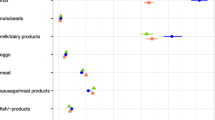Abstract
Nutrient profiles of foods are increasingly used as the scientific basis of nutritional labeling, health claims, or nutritional education. Nutrient profiling schemes are based on sets of rules, scores, or thresholds applied to the nutritional composition of foods. However, there is a lack of scientific validation of nutritional profiling schemes. To develop a reference method using existing dietary surveys, to define a set of indicator foods that are positively or negatively associated with a “healthy diet.” Such indicator foods can be used both for establishing relevant nutrient profiles and for the validation of existing or future nutrient profiling schemes. The proposed validation method is based on food and nutrient intakes of adults participating in national dietary surveys in five EU countries: Belgium (n = 2,507), Denmark (n = 3,151), France (n = 1,474), Ireland (n = 1,379), and Italy (n = 1,513). The characterization of indicator foods is divided in two steps. First, “healthy diets” of individuals are identified in the five national dietary surveys by comparison to the Eurodiet reference intakes. Second, indicator foods associated positively or negatively to the “healthy diets” are determined. With a P-value of 10−3 for the test of comparison of food intakes between the “most healthy eaters” and the “less healthy eaters,” it was possible to identify 294 indicator foods out of 1,669 foods tested in the five countries. In all the countries except Italy, there were more indicator foods positively associated than indicator foods negatively associated with the “healthy diet.” The food categories of these indicator foods were in good agreement with Food Based Dietary Guidelines like the USDA dietary guideline for Americans. A new reference method for the validation of profiling schemes was developed based on dietary intake data from using dietary surveys in five European countries. Only a minority of foods consumed in these dietary surveys could be used as indicator foods of healthy or unhealthy diets in order to subsequently test nutritional profiling schemes. Further work is needed to build a list of indicator foods that could be considered as a “gold standard.”
Similar content being viewed by others
References
Azaïs-Braesco V, Goffi C, Labouze E (2006) Nutrient profiling: comparison and critical analysis of existing systems. Public Health Nutr 9(5):613–622
Deutsche Gesellschaft für Ernährung, Östereichische Gesellschaft für Ernährung, Schweizerische Gesellschaft für Ernährungsforschung, Schweizerische Vereinigung für Ernährung (D-A-CH) (2000) Referenzwerte für die Nährstoffzufuhr. Umschau Baus Verlagsgesellschaft, Frankfurt a. M
Devriese S, Huybrechts I, Moreau M, Van Oyen H (2006) Enquête de consommation alimentaire belge 1–2004. Institut Scientifique de Santé Publique. Rapport D/2006/2505/16
EFCOSUM group (2001) European food consumption survey method, final report. TNO report V3766
European Parliament (2006) Position of the European Parliament adopted at second reading on 16 may 2006 with a view to the adoption of Regulation (EC) N° …/2006 of the European Parliament and of the Council on nutrition and health claims made on foods
Institute of Medicine (2000) Dietary reference intakes: applications in dietary assessment. The National Academies Press, Washington DC
Irish Universities Nutrition Alliance (IUNA) (2001) North/South Ireland food consumption survey, summary report. Food Safety Promotion Board, Dublin
Kafatos A, Codrington CA (1999) Nutrition and diet for healthy lifestyles in Europe: the “Eurodiet” project. Public Health Nutr 2(3A):327–328
Lachat C, Van Camp J, De Henauw S, Matthys C, Larondelle Y, Remaut-De Winter AM, Kolsteren P (2005) A concise overview of national nutrition action plans in the European Union Member States. Public Health Nutr 8(3):266–274
Lyhne N, Christensen T, Groth MV, Biltoft-Jensen A, Hartkopp H, Hinsch H, Matthiessen J, Møller A, Saxholt E, Trolle E (2005) Dietary habits in Denmark 2000–2002 (in Danish). Publ # 11, The Danish Institute for Food and Veterinary Research, Søborg
O’Neill M (2004) Traffic lights for food? How nutrient profiling can help make healthy choices become easy choices. National Consumer Council, June 2004
Rayner M, Scarborough P, Stockley L, Boxer A (2005) Nutrient profiles; Further refinement and testing of model SSCg3d. Final report [online], http://www.food.gov.uk/multimedia/pdfs/npreportsept05.pdf/ (accssed 30 October 2007)
Turrini A, Leclerc C, D’Amicis A (1999) Patterns of food nutrient intales in Italy and their application to the development of food-based dietary guidelines. Br J Nutr 81(Suppl2):S82–S89
Volatier JL (2000) Enquête Individuelle et Nationale sur les Consommations Alimentaires INCA (in French). Editions Lavoisier TEC&DOC, Paris, 158 p
World Health Organisation regional office for Europe (WHO-Europe) (2002) Food and health in Europe, a new basis for action. WHO regional office for Europe, Copenhagen, 31 pp
Acknowledgments
The authors would like to thank the participants of the Workshop ‘Nutritional Characterisation of Foods: Science-based Approach to Nutrient Profiling’, 25-27 April 2006, Spain for their useful comments and discussions.
This publication was coordinated by Carina Madsen, Scientific Project Manager at ILSI Europe. This work was commissioned by the Functional Foods Task Force of the European branch of the International Life Sciences Institute (ILSI Europe). Industry members of this task force are Ajinomoto Europe, Barilla G. & R. Fratelli, BASF, Bayer CropScience BioScience, Beneo-Orafti, Beverage Partners Worldwide, Campina, Coca-Cola European Union Group, Colloïdes Naturels International, CSM, Danisco, Dow Europe, Friesland Foods, Frutarom, GlaxoSmithKline, Groupe Danone, Kellogg, Kraft Foods, Mars, McNeil Nutritionals, Monsanto Europe-Africa, Nestlé, PepsiCo International, Procter & Gamble, Raisio, Red Bull, Royal Cosun, Südzucker, Tate & Lyle Speciality Sweeteners, Unilever, Valio, Wild Flavors, Wimm-Bill-Dann Foods, Yakult Europe. For further information about ILSI Europe, please call + 32 2 771.00.14 or email info@ilsieurope.be. The opinions expressed herein are those of the authors and do not necessarily represent the views of ILSI Europe.
Disclosure The authors have no conflict of interest to declare.
Author information
Authors and Affiliations
Consortia
Rights and permissions
About this article
Cite this article
Volatier, JL., Biltoft-Jensen, A., De Henauw, S. et al. A new reference method for the validation of the nutrient profiling schemes using dietary surveys. Eur J Nutr 46 (Suppl 2), 29–36 (2007). https://doi.org/10.1007/s00394-007-2004-5
Published:
Issue Date:
DOI: https://doi.org/10.1007/s00394-007-2004-5




